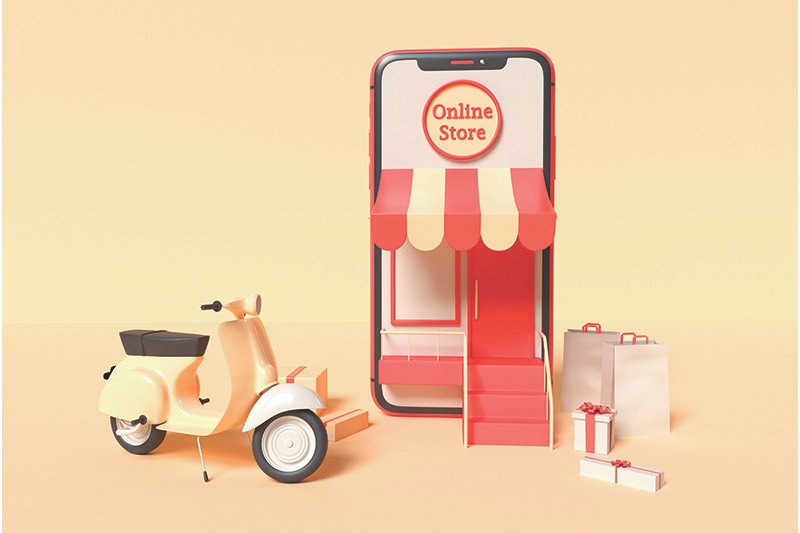
The phrase of the year 2020 was “The New Normal”, which was thrown around in gay abandon to recall and describe everything that happened during the time we all stayed indoors to keep ourselves safe from the raging pandemic outside. For businesses, the “New Normal” was going digital overnight. Everyone, from your neighbourhood café to your favourite apparel store, from your milkman to your gym, started offering their “online services”.But many failed unfortunately or couldn’t keep up with the teething issues because they never followed a process and fulfilled the must haves for any business to start their online shop. If you’re among those who’re still contemplating on it, then this is going to provide you more clarity and a focus on getting your shop online.

Build the BRAND
Some of the wildly popular brands you see online today weren’t overnight superstars online. They worked on building their identity, a relatability with their name, logo and products and services to the target audience.
Why, you ask?
Because taking a relatively unknown brand online with nothing to recall, is like jumping into water without a life jacket. So before you take the plunge, ensure you have the following boxes ticked A brand name, something which signifies the philosophy or service it offers.
A logo, for people to recall and form a connect with it, wherever we see it. For example, all of us can recall the logos of Skullcandy headphones, Ray Ethnic apparels, and Café Coffee Day cafes.
Choose your platform

Once you’ve set up your brand, the next step is to find the right platform to sell your products and services. But before you make your final decision on which platform to go with, you must go through the essential features it offers and if it ticks all the boxes for your brand.
Your platform must work on all kinds of devices. We at Flora Fountain take a mobile-centric approach every time we build an e-commerce website for a
client because our studies and research have shown that people tend to shop and explore more while on the move, on their smartphones. Hence it is important that the platform is mobile and tablet friendly.
Secondly, the platform must be able to integrate the various payment gateways and processors without any hitch.
The platform must come with its own inventory management feature so that you don’t have to shuffle through multiple spreadsheets every day.
And lastly, it must be able to sync with the many social media stores like Facebook Shop, Instagram Shop and Google Business.
For first time businesses who may or may not have much knowledge about code, Shopify is the way to go, thanks to its easy to set up procedures.
If you’re looking to add a shop feature to your WordPress website, the go with the WooCommerce plugin. And for business that deal in large quantities of sales, BigCommerce is what we’d suggest.
Market your market

There is a popular saying in the Gujarati language, “Bole Tena Bor Vechay” which loosely translates to “The one who speaks, sells”. And it’s true, until and unless you tell people about your product, your services and where can they find them, nobody is going to know. Because, like we mentioned earlier, almost everyone is going digital and there are chances that 10 of your competitors are already vying for the same spot as you.
Once you’ve set up your online online shop, it is time to market your market. Now there are many ways to do it, traditional marketing like newspaper advertising and outdoor billboards being among them. But they require large marketing budgets too.
If you’re looking spend only a fraction of that budget, target social media, since you’re already digital now. Ensure your brand has a page on almost every social media platform, talking about your online marketplace, the products you sell, the offers you’re giving on them.
Identify platforms which have their own online shop extensions, like Instagram Shop, Facebook Shop, Google Business, and Pinterest Shop.
Build a social media strategy, which identifies your probable customer base, plan your promotional posts accordingly, reach out to social media users who even makes a visit your page to create a recall about your brand and it’s availability on the digital marketplace.
Get in-sync on social media stores

Nowadays major social media platforms like Facebook, Instagram and even Pinterest have their own online store extensions. While it was initially created to help businesses with no website or experience in online marketplace management to sell their products and services on to people directly social media. Nowadays every major brand with their digital store or ecommerce website have their Facebook and Instagram Stores connected to each other.
When you sync your Facebook or Instagram Shop with your ecommerce website, every product picture you post online gets identified by the platform and it matches with product you’ve uploaded on your website. As a result it it not only showcases your product, but details of it and its prices too. With a single tap, the user can purchase it online, without even having to visiting your website.
In case you’re wondering how to set up and sync your store on Facebook or Instagram, check out this step by step procedure provided by Facebook themselves: Your Guide To Setting Up Shop.
Get analytical, track your progress

Any and every piece of data you could collect from your e-commerce platform and marketplace is gold and useful for you to understand the progress of your business online. Post building your online shop, kickstarting your social media campaigns and synchronising them to your social media stores, it is important that you track the statistics. The data that gets recorded are of the number of visits people make on your platform, the sales you make through it,
the kind of products/services they look at and the amount of time they spend on each of these pages. This helps you understand the consumer trend and if your marketing campaigns are performing at par with it. The one platform which is the most sought after when it comes to online business analytics and is available for free is Google Analytics.
In order to help you with the setting up of your Google Analytics for your website, here are two helpful links for you to which will guide you step by step.
Setting up Google Analytics on Shopify
Get started with Analytics, by Google
Now that you know the most important steps that need to be taken to make your ecommerce journey smooth and successful, it’s time you get started. And if you’re getting stuck somewhere, your friends at Flora Fountain are here to take you across the line. All you need to do is drop us a line here.



